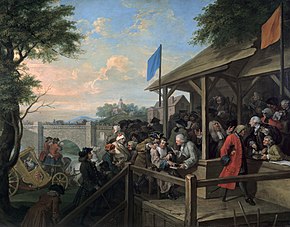
Back لون سياسي Arabic Color polític Catalan Politische Farbe German Colores políticos Spanish رنگ سیاسی Persian Couleur politique French צבעים בפוליטיקה HE Warna politik ID Colore politico Italian राजनैतिक रङ Nepali
This article has multiple issues. Please help improve it or discuss these issues on the talk page. (Learn how and when to remove these messages)
|

Political colours are colours used to represent a political ideology, movement or party, either officially or unofficially.[1] They represent the intersection of colour symbolism and political symbolism. Politicians making public appearances will often identify themselves by wearing rosettes, flowers, ties or ribbons in the colour of their political party. Parties in different countries with similar ideologies sometimes use similar colours. As an example the colour red symbolises left-wing ideologies in many countries (leading to such terms as "Red Army" and "Red Scare"), while the colour blue is often used for conservatism, the colour yellow is most commonly associated with liberalism and right-libertarianism, and Green politics is named after the ideology's political colour.[2][3] The political associations of a given colour vary from country to country, and there are exceptions to the general trends,[2][3] for example red has historically been associated with Christianity, but over time gained association with leftist politics, while the United States differs from other countries in that conservatism is associated with red and liberalism with blue.[2][3] Mass media has driven a standardisation of colour by political party, to simplify messaging, while historically the colour a candidate chose to identify with could have been chosen based on other factors such as family or regional variations.[4][5]
- ^ Sawer, Marian (1 May 2007). "Wearing your Politics on your Sleeve: The Role of Political Colours in Social Movements". Social Movement Studies. 6 (1): 39–56. doi:10.1080/14742830701251294. ISSN 1474-2837. S2CID 145495971.
- ^ a b c Cite error: The named reference
:0was invoked but never defined (see the help page). - ^ a b c Sawer, Marian (1 May 2007). "Wearing your Politics on your Sleeve: The Role of Political Colours in Social Movements". Social Movement Studies. 6 (1): 39–56. doi:10.1080/14742830701251294. ISSN 1474-2837. S2CID 145495971.
[The party colours in the UK] are red for Labour, yellow (gold) for the Liberal Democrats, blue for Conservatives, and green for Greens. This particular alignment of colours with the political spectrum tends to be taken for granted in much of the world [...].
- ^ Curtis, Katina (26 March 2022). "Labor is red, Liberals are blue: What's in a colour? It's political hue". The Sydney Morning Herald. Retrieved 20 December 2023.
- ^ "The seats where Tories weren't blue and Labour wasn't red". BBC News. 3 May 2015. Retrieved 20 December 2023.